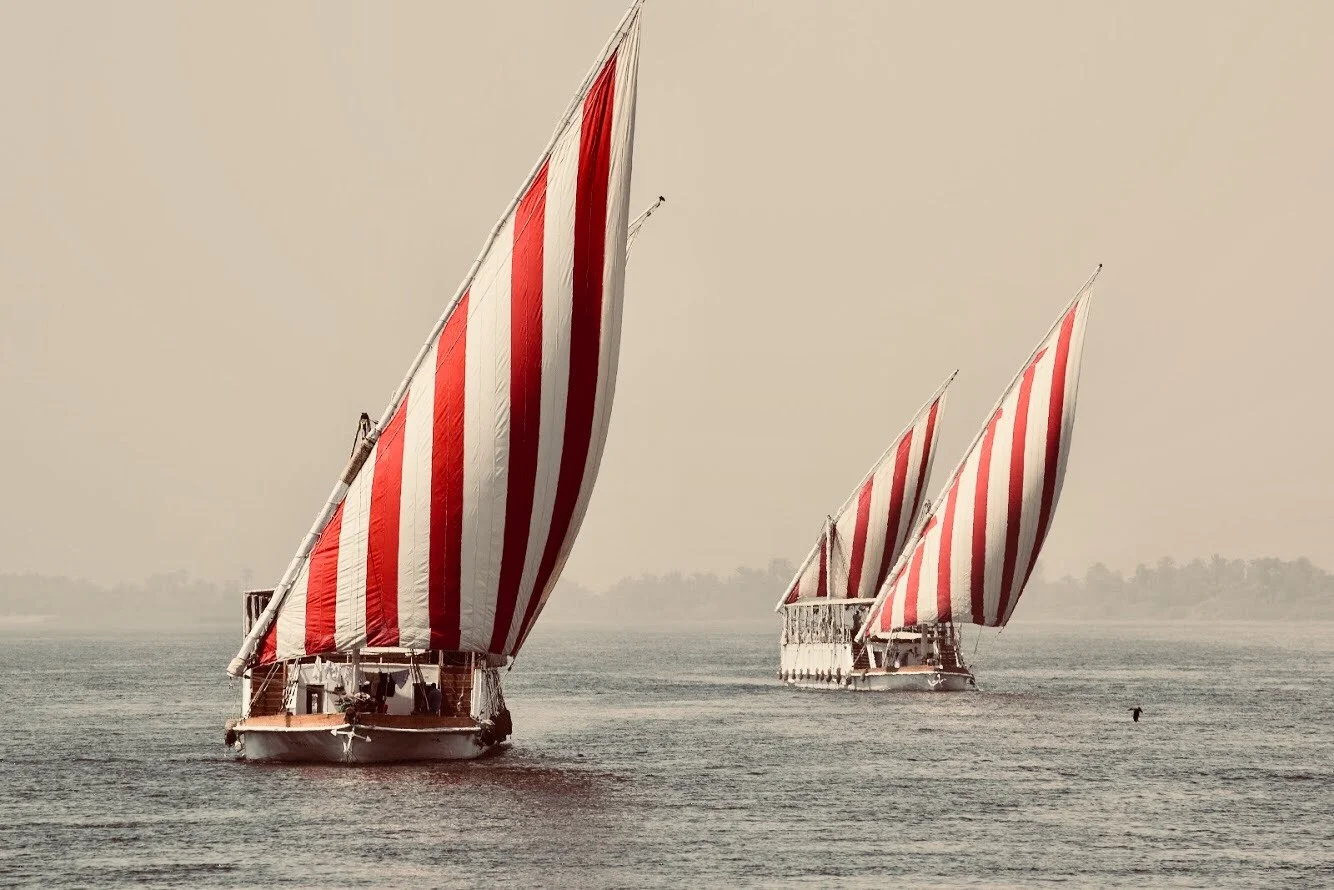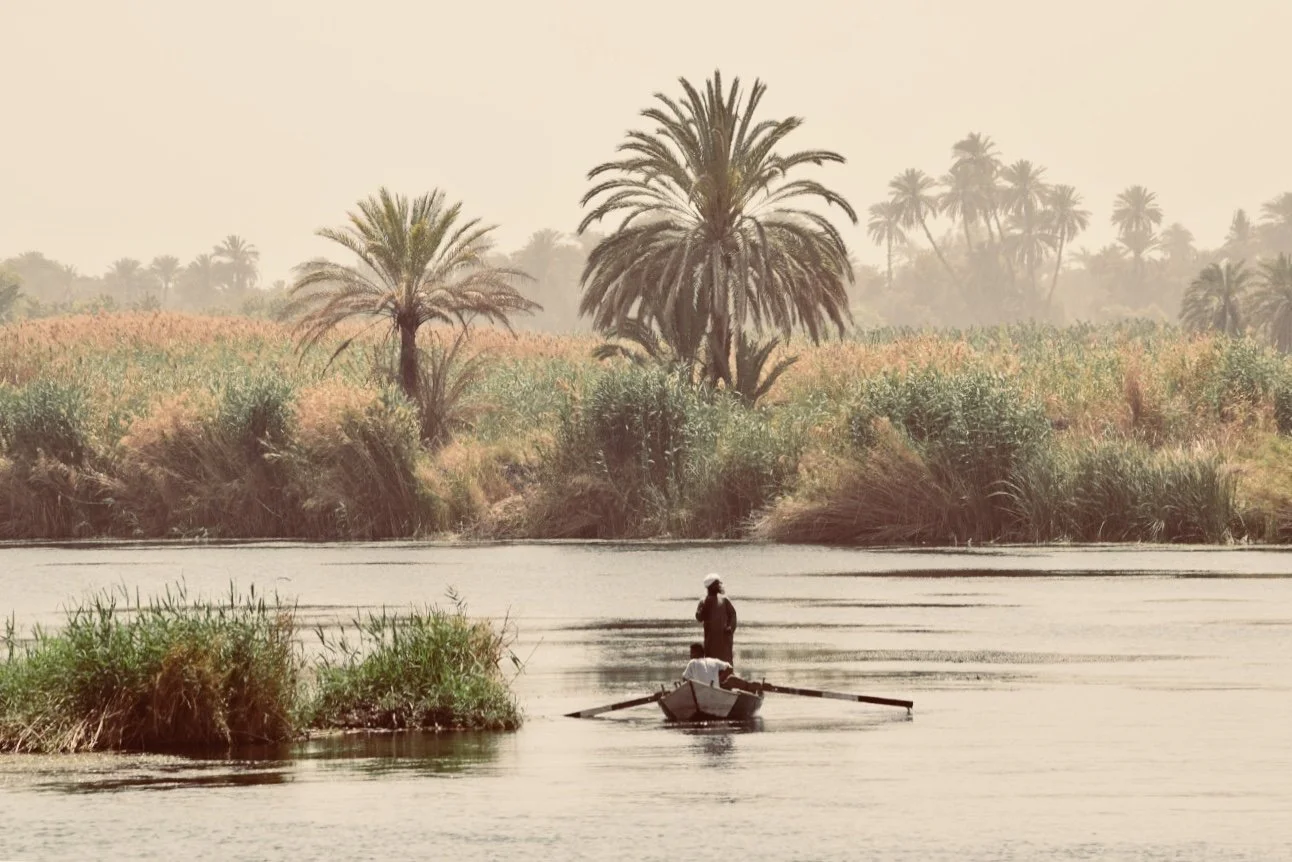Nour El Nil
Not every journey impresses with wonders of both man and nature. Fewer still unfold on a boat that looks borrowed from another century and drifts through a country older than time itself. Nour El Nil wasn’t dreamed up by cruise lines or hospitality boards, but by a family with a love for Egypt, a feel for stillness, and an understanding that luxury has less to do with thread counts than with how deeply something stays with you.
Tucked into the slow bend of the Nile, this isn’t a cruise so much as a passage—a gliding meditation through the heart of Egypt. The dahabiya doesn’t flash or dazzle. It sets the tone from the start—the creak of its wooden deck, the candy cane striped sails catching the breeze, the Nile glowing amber in the late sun. There are no television screens here, no name tags or forced fun. What there is, is a sense of wonder you don’t need to chase. It finds you, subtly, and then never quite lets go.
Photo by my father, Randy Meyer
BACKGROUND
I am not a cruise person. That’s where this dispatch should begin. I don’t love group itineraries, I distrust buffets on water, and the phrase “shore excursion” makes my skin itch. So when I elected to join a five-night journey down the Nile aboard Nour El Nil, it was with the kind of hesitancy usually reserved for blind dates or experimental dental work. I’d been to Africa before, but not like this—and certainly not on a boat with eight rooms, canvas sails, and no escape from forced small talk. Or so I thought.
What I found instead was the anti-cruise. A floating boutique hotel with 19th-century bones and 21st-century soul. Run by Enrique and his wife—our hosts during the voyage—the dahabiya (a traditional two-sail boat once used by royals and archaeologists) felt less like a tour and more like a private invitation to a more authentic version of Egypt. The version where the Nile glides by your window at dawn, palm trees line the shore in painterly silhouettes, and the only thing scheduled is wonder.
Egypt is not just a destination—it’s a cornerstone of civilization. Few places hold such a commanding place in both history and the imagination. For centuries, travelers have come drawn by its monumental past, but what stays with you is how present that history still feels. From the symmetry of its temples to the pulse of the Nile, Egypt offers a sense of scale—both human and timeless—that few places on Earth can match. Despite challenges, it remains one of the world’s most profound and perspective-shifting places to visit.
GETTING THERE
A journey with Nour El Nil is more accessible than one might expect. Our itinerary began in Cairo, a well-connected fairly modern airport. From there, a short flight delivers you to Luxor—less polished, more immediate—where the sailboat awaits just beyond the city’s edge, moored quietly along the banks of the Nile, ready to carry you into another rhythm entirely.
My father and I chose to arrive a day early to explore Luxor before the sail began. Miguel—Enrique’s son—had arranged a private tour that traced Luxor’s ancient soul. We descended into the tombs of the Valley of the Kings, walking through corridors etched with gods and time. The next morning, we rose above it all in a hot air balloon—gliding silently over temples and ruins bathed in golden light, while below, real archaeological digs unfolded with laborers carefully passing earth hand to hand like a living conveyor belt.
AcCOMMODATIONS
The dahabiya itself looked like a film set leftover from the golden age of travel: gleaming white wood, ruby-red sails, brass fixtures, small chandeliers, and canvas canopies shading a lounge deck straight out of a Graham Greene novel. The lower level houses just eight rooms—each one modestly sized, lovingly furnished, and surprisingly comfortable. All with air conditioning. My cabin had a plush bed, simple artwork, vintage light fixtures, and large windows that framed the river like a moving mural. You don’t just see Egypt from here. You drift through it.
the anti-cruise
The journey aboard Nour El Nil began in Esna, just south of Luxor with a visit to the Temple of Khnum, where 2,500-year-old pigments still blaze across the stone as if painted yesterday. Beneath its intricately carved ceilings, I didn’t just feel small—I felt momentary. That’s what Egypt does. It compresses time, folding centuries like linen, until the past feels not distant, but merely paused—waiting for you to notice.
Each stop along the river is handpicked and curated—by actual human beings, not algorithms or mass-tourism consultants. At El Kab, we wandered through crumbling necropolises carved into stone cliffs, where faded hieroglyphs still told stories of governors and nobles long buried beneath the dust. In Edfu, we stood beneath towering columns in one of Egypt’s best-preserved temples, dedicated to Horus, the falcon-headed god of protection and kingship—learning how its immense sandstone walls once guided both spiritual devotion and political power. At Gebel Silsileh, we explored a lesser-known site where sandstone was quarried to build the great temples of Luxor and Karnak. The scale of the rock-cut shrines here, hidden along the narrowest stretch of the Nile, felt intimate and untouched, as if time had paused just long enough for us to step in. In Kom Ombo, we visited the unusual double temple—half dedicated to Sobek, the crocodile god, and half to Horus—where we learned about ancient medicine, Nile floods, and how crocodiles once ruled these banks.
In between, we moored at sleepy villages or on virgin banks where donkeys outnumber cars and children still wave at passing boats. We swam in the Nile, wandered among golden dunes at dusk, and watched the sun melt behind palm groves as camels dragged sugarcane to the water’s edge—a tableau unchanged in five millennia, save for the farmer speaking into his mobile phone.
Photo by my father, Randy Meyer
Most mornings, my father was up before the sun, capturing images from the top deck with his Nikon that looked pulled from a National Geographic spread as the first light spilled across the river. I’d step ashore onto the reed-lined banks for a jog before the heat arrived, trailed by laughing local children trying their best to keep up.
As for the guests I had so dreaded—well, they turned out to be one of the greatest surprises of all. We were a small tribe of 14 that included a French diplomat couple, a Brazilian steakhouse magnate and his fiery wife, a famous fashion designer from Delhi with his entourage, a pair of inn keepers from Sicily, and us—the only Americans. One night, the Brazilians bought and slow-roasted an entire cow on the banks of the river, and we ate by lantern light, swapping stories in three languages under a sky bright with stars.
We disembarked in Aswan, where the river widens. We lingered for two extra nights at the legendary Sofitel Old Cataract Hotel, a place that feels plucked from another era, with pink granite walls and a guestbook that includes Agatha Christie and Winston Churchill. It was the perfect ending to a journey already defined by wonder.
FOOD + BEVERAGE
The food on board? Traditional, hearty, and lovingly made by the Egyptian crew. It won’t win over culinary purists, but that’s not the point. This is nourishment of a different kind: chickpeas and rice, grilled fish, slow-cooked lamb, the occasional lemony soup—all served at a communal table that, somehow, never once felt obligatory. The conversations were rich, the wine flowed freely, and no one needed a dress code to understand they were somewhere special.
final thoughts
There are larger ships, grander rooms, flashier amenities. But you won’t find this kind of quiet, handwoven travel. Not often. Not anymore. Rather than scaling up with larger, impersonal ships, Nour El Nil has stayed true to its roots—expanding thoughtfully by building more elegant dahabiyas, each as intimate and carefully crafted as the original.
Nour El Nil is not just a boat—it’s a way of seeing. A way of slowing down, of traveling not across a country but through it, feeling the pulse of the Nile as generations have before. It trades spectacle for soul, and luxury for intimacy. You drift not only past temples and tombs, but into conversations, quiet moments, and scenes that linger long after you’ve returned home. In a world that moves too fast, this journey moves with purpose. Gracefully. Gently. And if you're lucky, it changes how you travel—maybe even how you see.




